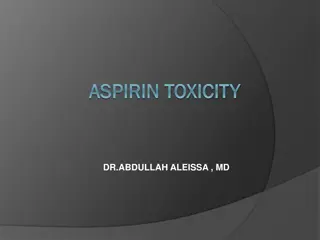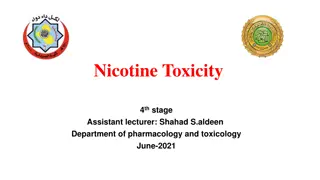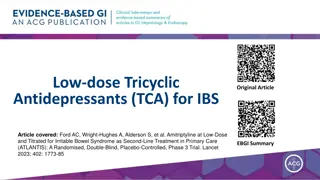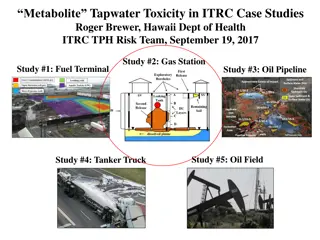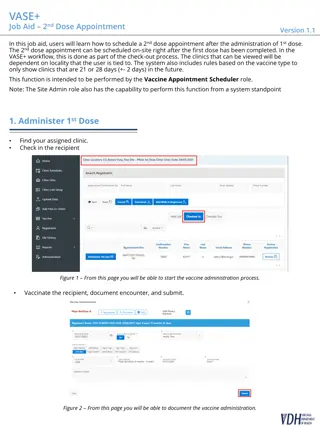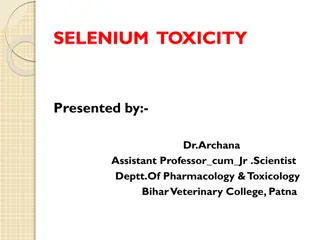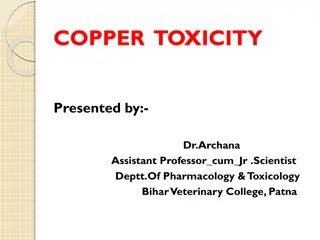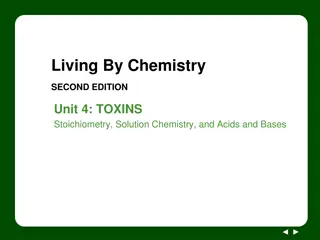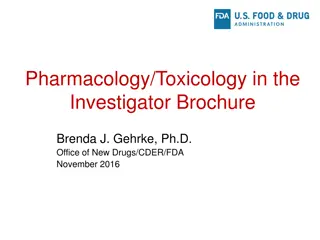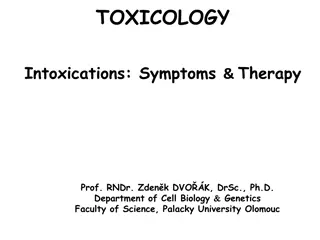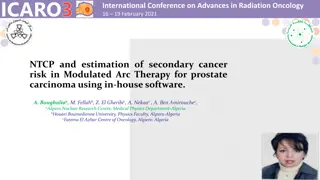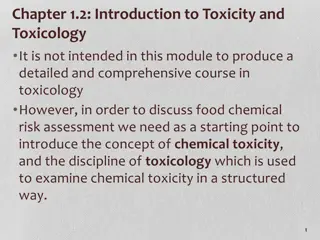Understanding Toxicology: Dose-Response and Toxicity Assessment
The study of toxicology involves understanding dose-response relationships, lethal concentrations, tolerance limits, toxicity curves, and factors influencing toxicity. Dose, response, acute toxicity, chronic toxicity, LD50, and ED50 are key concepts in toxicology that help assess the effects of chemicals on living organisms. Different routes of exposure and long-term effects are considered in toxicity evaluation to ensure safety and protect health.
Download Presentation

Please find below an Image/Link to download the presentation.
The content on the website is provided AS IS for your information and personal use only. It may not be sold, licensed, or shared on other websites without obtaining consent from the author. Download presentation by click this link. If you encounter any issues during the download, it is possible that the publisher has removed the file from their server.
E N D
Presentation Transcript
TOXICOLOGY B. Sc. THIRD YEAR PAPER I
Outline- Dose-response Dose Response Lethal concentrations Tolerance limits Dose-response relationships LD50 and LC50 Margin of safety TOXICITY CURVES
FACTORS THAT INFLUENCE TOXICITY ACUTE EXPOSURE SUB CHRONIC CHRONIC DOSE RESPONSE
Dose The amount of chemical entering the body This is usually given as mg of chemical/kg of body weight = mg/kg The dose is dependent upon The concentration The properties of the toxicant The timing and frequency of exposure The length of exposure The exposure pathway
What is a Response? The degree of responses depend upon the dose and the organism Change from normal state could be on the molecular, cellular, organ, or organism level--the symptoms Local vs. Systemic Reversible vs. Irreversible Immediate vs. Delayed Monotonic response increases with dose (cyanide and many traditional toxicants) Nonmonotic response does not increase with dose (hormones, endocrine disruptors, micronutrients and vitamins)
DOSE LIMITS- ACUTE TOXICITY Acute toxicity: It involves lethal concentrations and short-term exposures . The end point is usually death ROUTE that carries toxic substances to blood stream and the LETHALITY are dependent on each other Three routes are used to determine MEDIUM LETHAL DOSE (LD50) ORAL DERMAL INHALATION LD50 is a dose of a toxic chemical that kills half of the population. LD50 is obtained by plotting, for a given dose the proportion of the population that responded to that dose and all lower doses .
CHRONIC TOXICITY Chronic toxicity: It involves Sub-lethal concentration and long-term exposure Chronic toxicity test is used to derive Effective Dose ED50: Is the dose by which half of the population has been affected Effect could be anything but death ED50 is obtained by plotting, for a given dose the proportion of the population that responded to that dose and all lower doses
Dose response Definition: The characteristics of exposure and the spectrum of effects come together in a correlative relationship customarily referred to as the dose-response relationship Two types: Individual to varying doses of a chemical Population of individuals
DOSE RESPONSE CURVE- basic principles A CURVE describing the relationship between the dose (quantity) of the chemical administered and the percentage response of the test population THRESHOLD CONCENTRATION - a concentration above which some effect or response will be produced and below which it will not Every interaction of the toxicant is either reversible or irreversible and generate a proportional response od varied type Variability in the response of the individual to dose may be expressed graphically by distribution curve
Monotonic Dose Response LD50 Quantal responses can be treated as gradient when data from a population is used. The cumulative proportion of the population responding to a certain dose is plotted per dose (10-30 fold variation w/in a population) If Mortality is the response, the dose that is lethal to 50% of the population LD50 can be generated from the curve Different toxicants can be compared (lowest dose is most potent)
TOXICITY CURVE No Observable Adverse Effect Level (NOAEL) the threshold where no effects are observed. Lowest Observable Adverse Effect Level (LOAEL) the concentration level where effects are observed.
Interaction of chemicals Additive effect The combine effects of two chemicals is equal to the sum of the effects of each agent given alone 1) Example: 2 + 3 = 5 2) Organophosphous pesticides Cholinesterase inhibition Synergistic effect The combine effects of two chemicals are greater to the sum of the effects of each agent given alone 1) Example: 2 + 2 = 20 2) Carbon tetrachloride and ethanol induced hepatoxicity
Interaction of chemicals 3. Potentiation effect One chemical dose not has a toxic effect on a certain organ but when added another chemical 1) Example: 0 + 2 = 10 2) Isopropanol is not hepatoxic, but enhance carbon tetrachloride induced hepatoxicity 4. Antagonistic effect The combine effects of two chemicals interfere with each other s action 1) Example: 4 + 0 = 1 2) Dimercaprol (BAL) chelates with metal ions, As, Pb . 3) Atropine and PAM are OP antidotes 4) Metal-binding protein, Metallothionein binding with Cd
Comparison of dose response: Therapeutic index (TI) - TI is defined as the ratio of the dose required to produce a toxic effect and the dose needed to elicit their desired therapeutic response. For drugs use in risk assessment TI = LD50/ED50 The higher TI is relative safety Marginal of safety (MOS): For nondrug chemicals use in risk assessment Estimated exposed dose to a human population and the highest nontoxic dose determined in experimental animals MOS = LD1/ED99
The dose-effect relationship is the relationship between dose and effect on the individual level. An increase in dose may increase the intensity of an effect, or a more severe effect may result. A dose-effect curve may be obtained at the level of the whole organism, the cell or the target molecule. Some toxic effects, such as death or cancer, are not graded but are all or none effects. It is essential to toxicology to establish dose-effect and dose-response relationships. In medical (epidemiological) studies a criterion often used for accepting a causal relationship between an agent and a disease is that effect or response is proportional to dose.
Several dose-response curves can be drawn for a chemical one for each type of effect. The dose-response curve for most toxic effects (when studied in large populations) has a sigmoid shape. T here is usually a low-dose range where there is no response detected; as dose increases, the response follows an ascending curve that will usually reach a plateau at a 100% response. The dose-response curve reflects the variations among individuals in a population. The slope of the curve varies from chemical to chemical and between different types of effects. For some chemicals with specific effects (carcinogens, initiators, mutagens) the dose- response curve might be linear from dose zero within a certain dose range. This means that no threshold exists and that even small doses represent a risk. Above that dose range, the risk may increase at greater than a linear rate.
LD50(effective dose) is the dose causing 50% lethality in an animal population. The LD50is often given in older literature as a measure of acute toxicity of chemicals. The higher the LD50, the lower is the acute toxicity. A highly toxic chemical (with a low LD50) is said to be potent. There is no necessary correlation between acute and chronic toxicity. ED50(effective dose) is the dose causing a specific effect other than lethality in 50% of the animals. NOEL (NOAEL) means the no observed (adverse) effect level, or the highest dose that does not cause a toxic effect. To establish a NOEL requires multiple doses, a large population and additional information to make sure that absence of a response is not merely a statistical phenomenon. LOEL is the lowest observed effective dose on a dose-response curve, or the lowest dose that causes an effect.
A safety factor is a formal, arbitrary number with which one divides the NOEL or LOEL derived from animal experiments to obtain a tentative permissible dose for humans. This is often used in the area of food toxicology, but may be used also in occupational toxicology. A safety factor may also be used for extrapolation of data from small populations to larger populations. safety factors range from 100to 103. A safety factor of two may typically be sufficient to protect from a less serious effect (such as irritation) and a factor as large as 1,000 may be used for very serious effects (such as cancer). The term safety factor could be better replaced by the term protection factor or, even, uncertainty factor. The use of the latter term reflects scientific uncertainties, such as whether exact dose-response data can be translated from animals to humans for the particular chemical, toxic effect or exposure situation.




